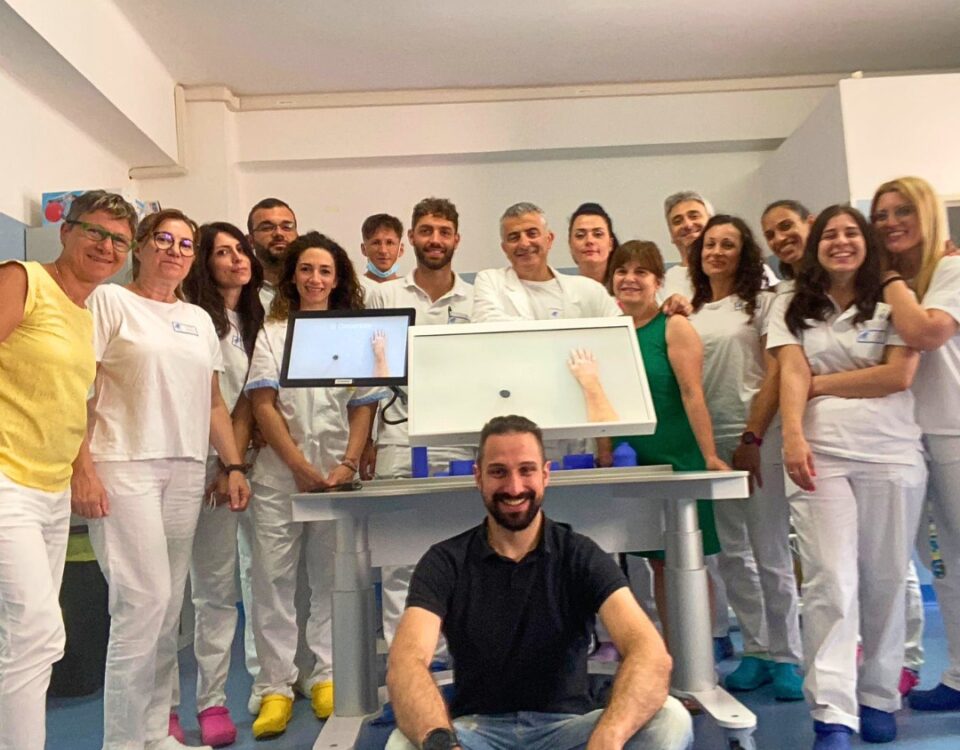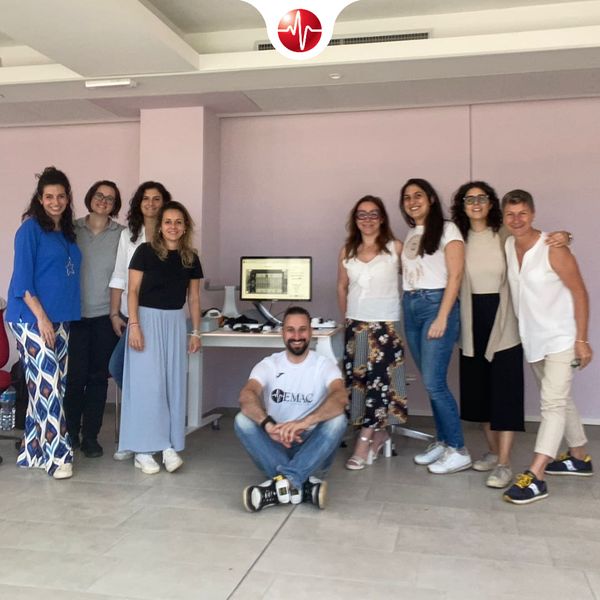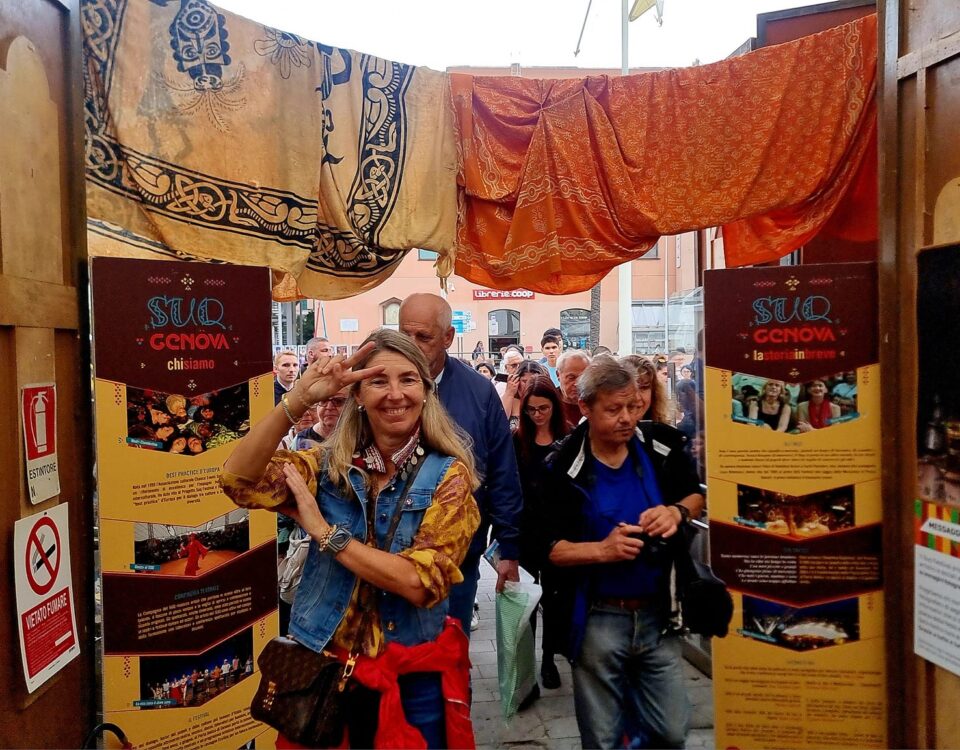
18 Mar 2015 – Articolo “il Tirreno” – La sala operatoria del futuro
9 Luglio 2015
EMAC partecipa come sponsor al Festival della Mente di Sarzana 2015
3 Settembre 2015
18 Mar 2015
Comunicati Stampa S.Raffaele (Roma) acquista un EKSO
Scritto da Rus | TMNews –
Il S.Raffaele adotta l'esoscheletro bionico che aiuta a camminareRoma, 10 mar. (askanews) - Stare in piedi di nuovo. Camminare ancora. E tornare a guardare il mondo negli occhi. Non sarà più solo un sogno per quei pazienti che a causa di traumi o patologie neurodegenerative condividono i giorni con una sedia a rotelle. Sarà possibile presso l'Irccs San Raffaele Pisana di Roma grazie all'esoscheletro bionico Ekso, modernissimo gioiello della tecnologia nel campo della riabilitazione degli arti inferiori.
Scritto da Rus | TMNews –
Il S.Raffaele adotta l'esoscheletro bionico che aiuta a camminareRoma, 10 mar. (askanews) - Stare in piedi di nuovo. Camminare ancora. E tornare a guardare il mondo negli occhi. Non sarà più solo un sogno per quei pazienti che a causa di traumi o patologie neurodegenerative condividono i giorni con una sedia a rotelle. Sarà possibile presso l'Irccs San Raffaele Pisana di Roma grazie all'esoscheletro bionico Ekso, modernissimo gioiello della tecnologia nel campo della riabilitazione degli arti inferiori.
L'Istituto capitolino sarà il primo centro laziale ad utilizzare il device progettato e studiato negli Stati Uniti per il training riabilitativo del cammino di pazienti affetti da patologie neurologiche come lesioni midollari, ictus, sclerosi multipla, lesioni cerebrali traumatiche e sindrome di Guillain Barrè. "L'esoscheletro robotico indossabile, realizzato in acciaio e carbonio", spiega Claudio Ceresi, Responsabile Riabilitazione Italia dell'Emac di Genova, azienda leader nel settore dei dispositivi biomedici, "si indossa come fosse una tuta e viene azionato da quattro motori elettromeccanici alimentati da due batterie che garantiscono un'autonomia di circa quattro ore. Sedici sensori collegati al corpo del paziente permettono al robot di trasformare le sue intenzioni in movimenti delle gambe". L'équipe specialistica afferente all'unità operativa di neuroriabilitazione del San Raffaele, diretta dal Prof. Marco Franceschini, sta perfezionando in questigiorni il training formativo con esperti internazionali al fine di poter trattare i primi pazienti già dagli inizi di aprile. Il sistema oltre ai vantaggi fisioterapici consente ai pazienti che lo utilizzano notevoli progressi sia da un punto di vista psicologico che della qualità di vita. Come spiega Patrizio Sale, responsabile dell'area di Ricerca Robotica dell'Istituto di via della Pisana, "gli esoscheletri vengono sviluppati per consentire a persone con difficoltà di movimento di alzarsi, stare in piedi e camminare,contribuendo così anche a migliorare la loro forza e resistenza. Pur non sostituendo completamente la sedia a rotelle, le gambe bioniche consentono ad esempio ai loro utilizzatori di lavorare nuovamente anche in posizione eretta". Una posizione eretta per sfidare il destino e per poter vedere oltre quella siepe che troppo spesso "da tanta parte il guardo esclude".
----------------------------------------------------------------------------------------------------------------------------------------------------------------------------------------------------------------------- Dalla sedia a rotelle, alla libertà di moto. L'esoscheletro una realtà al San Raffaele
AFFARITALIANI.IT
Arriva anche a Roma e nel Lazio l'innovazione scientifica che consente di stare di nuovo in piedi e camminare pazienti affetti da patologie neurologiche come lesioni midollari, ictus, sclerosi multipla, lesioni cerebrali traumatiche e sindrome di Guillain Barré.
L'uomo bionico diventa realtà al San Raffaele, LE IMMAGINI
Martedì, 10 marzo 2015 - 14:58:00
Stare inpiedi di nuovo. Camminare ancora. E tornare a guardare il mondo negli occhi.Non sarà più solo un sogno per quei pazienti che a causa di traumi o patologie neurodegenerative condividono i giorni con una sedia a rotelle. L'innovazione che ha restituito la mobilità alla 29enne napoletana Manuela Migliaccio, paraplegica dopo una caduta da un muretto, arriva anche a Roma. E sarà possibile presso l'IRCCS San Raffaele Pisana di Roma grazie all'esoscheletro bionico EKSO, modernissimo gioiello della tecnologia nel campo della riabilitazione degli arti inferiori. L'Istituto capitolino sarà il primo centro laziale ad utilizzare il device progettato e studiato negli Stati Uniti per il training riabilitativo del cammino di pazienti affetti da patologie neurologiche come lesioni midollari, ictus, sclerosi multipla, lesioni cerebrali traumatiche e sindrome di Guillain Barré. "L'esoscheletro robotico indossabile, realizzato in acciaio e carbonio - ha spiegato Claudio Ceresi, Responsabile Riabilitazione Italia dell'EMAC di Genova, azienda leader nel settore dei dispositivi biomedici - si indossa come fosse una tuta e viene azionato da quattro motori elettromeccanici alimentati da due batterie che garantiscono una autonomia di circa quattro ore. Sedici sensori collegati al corpo del paziente permettono al robot di trasformare le sue intenzioni in movimenti delle gambe". L'equipe specialistica afferente all'unità operativa di neuroriabilitazione del San Raffaele, diretta da Marco Franceschini, sta perfezionando in questi giorni il training formativo con esperti internazionali al fine di poter trattare i primi pazienti già dagliinizi di aprile. "Gli esoscheletri - ha spiegato Patrizio Sale, responsabile dell'area di Ricerca Robotica dell'Istituto di via della Pisana - vengono sviluppati per consentire a persone con difficoltà di movimento di alzarsi, stare in piedi e camminare, contribuendo così anche a migliorare la loro forza e resistenza. Pur non sostituendo completamente la sedia a rotelle, le gambe bioniche consentono ad esempio ai loro utilizzatori di lavorare nuovamente anche in posizione eretta".
-------------------------------------------------------------------------------------------------------------------------------------------------------------------------------------------------------------------------- Salute: al San Raffaele di Roma esoscheletro bionico per camminare
(AGI) - Roma, 10 mar. - Stare in piedi di nuovo. Camminare ancora. E tornare a guardare il mondo negli occhi. Non sara' piu' solo un sogno per quei pazienti che a causa di traumi o patologie neurodegenerative condividono i giorni con una sedia a rotelle. Sara' possibile presso l'IRCCS San Raffaele Pisana di Roma grazie all'esoscheletro bionico EKSO, modernissimo gioiello della tecnologia nel campo della riabilitazione degli arti inferiori. (AGI)
(AGI) - Roma, 10 mar. - L'Istituto capitolino sara' il primo centro laziale ad utilizzare il device progettato e studiato negli Stati Uniti per il training riabilitativo del cammino di pazienti affetti da patologie neurologiche come lesioni midollari, ictus, sclerosi multipla, lesioni cerebrali traumatiche e sindrome di Guillain Barre'. "L'esoscheletrorobotico indossabile, realizzato in acciaio e carbonio - ha spiegato Claudio Ceresi, Responsabile Riabilitazione Italia dell'EMAC di Genova, azienda leader nel settore dei dispositivi biomedici - si indossa come fosse una tuta e viene azionato da quattro motori elettromeccanici alimentati da due batterie che garantiscono una autonomia di circa quattro ore. Sedici sensori collegati al corpo del paziente permettono al robot di trasformare le sue intenzioni in movimenti delle gambe". L'equipe specialistica afferente all'unita' operativa di neuroriabilitazione del San Raffaele, diretta da Marco Franceschini, sta perfezionando in questi giorni il training formativo con esperti internazionali al fine di poter trattare i primi pazienti gia' dagli inizi di aprile. "Gli esoscheletri- ha spiegato Patrizio Sale, responsabile dell'ar.
----------------------------------------------------------------------------------------------------------------------------------------------------------------------------------------------------------------------- Dalla sedia a rotelle, alla libertà di moto. L'esoscheletro una realtà al San Raffaele
AFFARITALIANI.IT
Arriva anche a Roma e nel Lazio l'innovazione scientifica che consente di stare di nuovo in piedi e camminare pazienti affetti da patologie neurologiche come lesioni midollari, ictus, sclerosi multipla, lesioni cerebrali traumatiche e sindrome di Guillain Barré.
L'uomo bionico diventa realtà al San Raffaele, LE IMMAGINI
Martedì, 10 marzo 2015 - 14:58:00
Stare inpiedi di nuovo. Camminare ancora. E tornare a guardare il mondo negli occhi.Non sarà più solo un sogno per quei pazienti che a causa di traumi o patologie neurodegenerative condividono i giorni con una sedia a rotelle. L'innovazione che ha restituito la mobilità alla 29enne napoletana Manuela Migliaccio, paraplegica dopo una caduta da un muretto, arriva anche a Roma. E sarà possibile presso l'IRCCS San Raffaele Pisana di Roma grazie all'esoscheletro bionico EKSO, modernissimo gioiello della tecnologia nel campo della riabilitazione degli arti inferiori. L'Istituto capitolino sarà il primo centro laziale ad utilizzare il device progettato e studiato negli Stati Uniti per il training riabilitativo del cammino di pazienti affetti da patologie neurologiche come lesioni midollari, ictus, sclerosi multipla, lesioni cerebrali traumatiche e sindrome di Guillain Barré. "L'esoscheletro robotico indossabile, realizzato in acciaio e carbonio - ha spiegato Claudio Ceresi, Responsabile Riabilitazione Italia dell'EMAC di Genova, azienda leader nel settore dei dispositivi biomedici - si indossa come fosse una tuta e viene azionato da quattro motori elettromeccanici alimentati da due batterie che garantiscono una autonomia di circa quattro ore. Sedici sensori collegati al corpo del paziente permettono al robot di trasformare le sue intenzioni in movimenti delle gambe". L'equipe specialistica afferente all'unità operativa di neuroriabilitazione del San Raffaele, diretta da Marco Franceschini, sta perfezionando in questi giorni il training formativo con esperti internazionali al fine di poter trattare i primi pazienti già dagliinizi di aprile. "Gli esoscheletri - ha spiegato Patrizio Sale, responsabile dell'area di Ricerca Robotica dell'Istituto di via della Pisana - vengono sviluppati per consentire a persone con difficoltà di movimento di alzarsi, stare in piedi e camminare, contribuendo così anche a migliorare la loro forza e resistenza. Pur non sostituendo completamente la sedia a rotelle, le gambe bioniche consentono ad esempio ai loro utilizzatori di lavorare nuovamente anche in posizione eretta".
-------------------------------------------------------------------------------------------------------------------------------------------------------------------------------------------------------------------------- Salute: al San Raffaele di Roma esoscheletro bionico per camminare
(AGI) - Roma, 10 mar. - Stare in piedi di nuovo. Camminare ancora. E tornare a guardare il mondo negli occhi. Non sara' piu' solo un sogno per quei pazienti che a causa di traumi o patologie neurodegenerative condividono i giorni con una sedia a rotelle. Sara' possibile presso l'IRCCS San Raffaele Pisana di Roma grazie all'esoscheletro bionico EKSO, modernissimo gioiello della tecnologia nel campo della riabilitazione degli arti inferiori. (AGI)
(AGI) - Roma, 10 mar. - L'Istituto capitolino sara' il primo centro laziale ad utilizzare il device progettato e studiato negli Stati Uniti per il training riabilitativo del cammino di pazienti affetti da patologie neurologiche come lesioni midollari, ictus, sclerosi multipla, lesioni cerebrali traumatiche e sindrome di Guillain Barre'. "L'esoscheletrorobotico indossabile, realizzato in acciaio e carbonio - ha spiegato Claudio Ceresi, Responsabile Riabilitazione Italia dell'EMAC di Genova, azienda leader nel settore dei dispositivi biomedici - si indossa come fosse una tuta e viene azionato da quattro motori elettromeccanici alimentati da due batterie che garantiscono una autonomia di circa quattro ore. Sedici sensori collegati al corpo del paziente permettono al robot di trasformare le sue intenzioni in movimenti delle gambe". L'equipe specialistica afferente all'unita' operativa di neuroriabilitazione del San Raffaele, diretta da Marco Franceschini, sta perfezionando in questi giorni il training formativo con esperti internazionali al fine di poter trattare i primi pazienti gia' dagli inizi di aprile. "Gli esoscheletri- ha spiegato Patrizio Sale, responsabile dell'ar.




